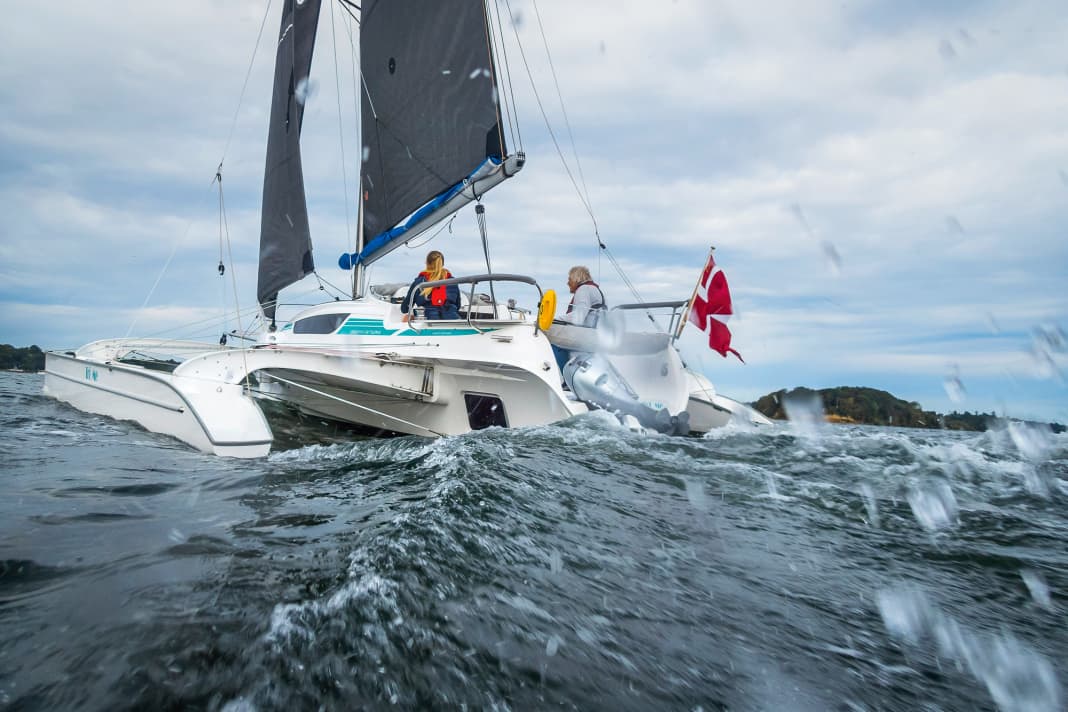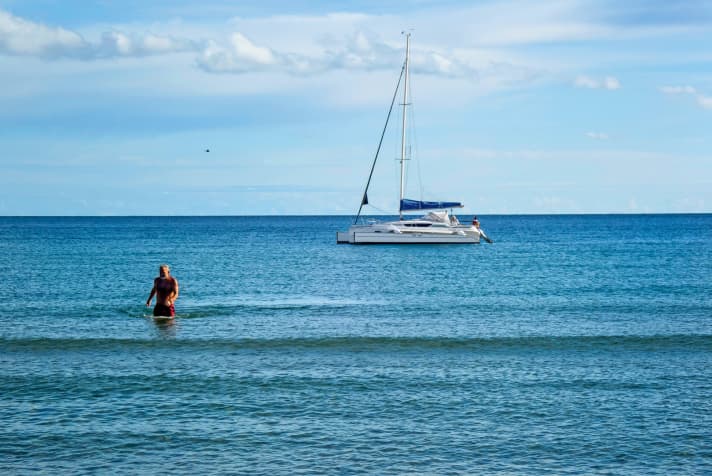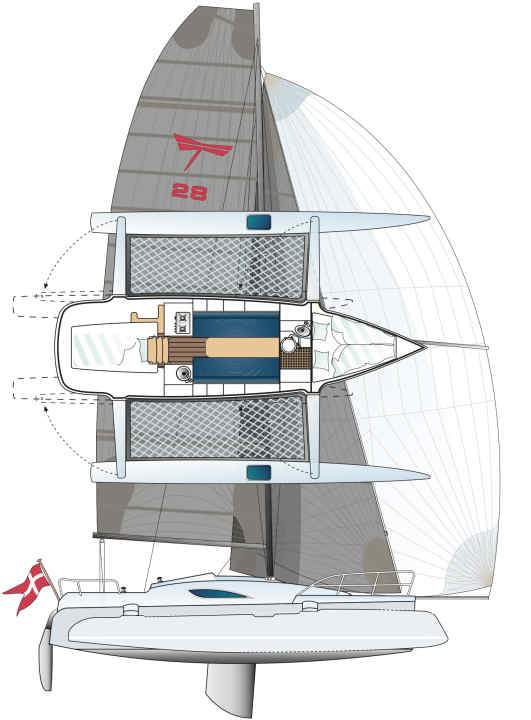Dragonfly 28: On a charter cruise in Denmark with the folding trimaran
Christian Irrgang
· 17.11.2023






"And finally, the most important thing: never forget to hook in the safety wire!" This prevents the Dragonfly from immediately putting its wings back on as soon as someone steps on the trampoline between the centre hull and the float. Just this last step is needed before the three-legged boat floats in the harbour basin, ready to sail. Flemming, an employee of Quorning Boats in Skærbæk, showed us how quickly and easily a Dragonfly can be unfolded to its full span of 6.50 metres. It felt like the manoeuvre took barely more than three minutes. Then a few strokes outside the entrance: Flemming patiently answers our questions and explains exactly what to look out for with a trimaran.
We would like to spend a few days sailing a Dragonfly 28 in the touring version. The boat with the descriptive name "Tri Me" is chartered out by the shipyard. We want to try out how such a projectile sails. After all, Jens Quorning has written a success story with this boat that makes us curious. 266 twenty-eights have been completed since 2009, one every 15 working days. So what makes this thing so successful?
Sailing a trimaran feels like driving a go-kart
We motor out of the harbour entrance. The boat weighs just over two tonnes, which makes it very susceptible to wind. Outside, we look for a place with enough space on all sides to set the main. It's quite simple in principle, but everything is still new and unfamiliar to us, so it takes time.
It is already half past one when we pass the Strib beacon opposite Fredericia and open water lies ahead of us. The sky has been grey since this morning, the wind is still blowing weakly to moderately from the north-west, but is supposed to pick up. We had set our sights on Samsø for this evening, but is that realistic, just under 40 miles? We decide to set our course entirely according to the wind. Let's see how far we get. It's brightening up a bit out here now and the sun is coming out.
We tighten the sheets and look at the speedometer as if spellbound: seven knots, eight, nine, ten. A small gust and the display jumps to 14!
We look for an angle of about 60 degrees to the true wind, tighten the sheets and look at the speedometer as if mesmerised. Seven knots, eight, nine, ten for the first time. A small gust and the display jumps to 14! For a long keel sailor like me, that's bordering on magic. When the Multi accelerates, I feel more like the pilot of a go-kart with my foot on the accelerator than the helmsman of a sailing boat.
Jerky control movements must be avoided at all costs
The tiller lies in the hand without any pressure at all. Even the slightest deflection has maximum effect. Fast, jerky movements must be avoided at all costs. A small moment of inattention can cause the whole boat to skid and the centrifugal forces can pull the other sailor from his seat. If the helmsman then reflexively grabs hold of the tiller, it's all too late. We can just about catch the coffee cup, which is carelessly left on the saloon table because the Tri is sailing completely upright, before it flies through the cabin in a high arc. On the other hand, you can't just let go of the tiller for a moment, otherwise the boat will immediately run off course.
We luff up. Let's see how high we can go. An astonishing 30 degrees is actually possible, and we're still travelling at six to seven knots. That would be the maximum speed on my boat, but here we feel like we're about to come to a standstill. So we drop back down a bit, we already find anything under ten knots boring. How quickly you can get used to something like that! And the best thing is that this course, 60 degrees to the wind, is not only the fastest, but actually exactly what we need to easily pass the northern tip of Æbelø and head towards Samsø. In the meantime, the wind is blowing fairly constantly at 4 Beaufort, and the display on the log is engraved at twelve knots.
It only took us four and a half hours to cover the 42 miles from Strib to Ballen. That's an average of around ten knots. And it was completely stress-free and effortless
However, the conditions this afternoon are also ideal for a speedy trip. Sun, wind and smooth water, pure pleasure. We sit very comfortably in the back of the cockpit, slightly elevated on the folding seats in the pushpit, where we can put our legs up like in a deckchair. At 5 p.m. we have passed the Lushage beacon and thus the south-eastern corner of Samsø. Ballen harbour is so empty that we can do without folding in the floats. In the glow of the evening sun, we manoeuvre the Dragonfly backwards between the piles and moor alongside a pier. It took us no less than four and a half hours to cover the 42 miles from Strib to here, which is around ten miles per hour. And it was completely stress-free, absolutely effortless. Can you believe it?
You plan a multi-trip very differently to a mono trip
The next morning, a warm late summer sun wakes us up. Right next door is a wide, sheltered bay with a white sandy beach. Ideal for a swim at anchor. The folding centreboard, fully extended to a depth of 1.70 metres, is quickly raised, but unfortunately the rudder blade is jammed. This means we can't fully utilise the shallow draught, which would normally allow us to sail to knee depth off the beach. Theoretically, it is even possible to pull the boat directly onto the beach.

We pick up the anchor again around midday, stow it in the starboard float and set sail. We planned to sail around Funen yesterday, which would be pretty ambitious in the light winds forecast and in the short time we have with a normal monohull. But with the Dragonfly, why not? We've been promised a south-westerly wind, so let's give it a go. You plan a cruise with a multi very differently to one with a mono.
Aft winds are less exciting. It only gets interesting when the breeze is more than half ahead. That's why we're delighted when we steer into the Great Belt from the north and are able to approach our 60 degrees again. But the wind is shifting and weak. The blister has to come out of the bag, otherwise we'll have to stop. But even this big sheet is no help in a calm.
Fortunately, this situation doesn't last long. Suddenly the wind is back, from the old direction. It is blowing quietly at us from Kerteminde Bay. The blister is recovered in no time at all, the genoa is unfurled and we are back in the race. The log now jumps to eight knots. But then, about ten miles from the big bridge, the wind shifts and suddenly comes directly from the front.
When folded, the Dragonfly 28 fits into any box
Without further ado, we take the helm and head back. We arrive in Kerteminde a few moments after sunset. It's cramped here, much more so than yesterday in Ballen. There are only narrow boxes behind stern posts everywhere. We turn the Dragonfly into a folding boat for the first time. Once the safety wires are unhooked, the line that pulls the float in can still be pulled in hand over hand. However, this soon becomes too difficult and you continue with the help of the Schotwinsch. It takes a few minutes until both floats are really tight, and at the very end it gets a bit strenuous because the floats have to lift the centre hull about ten centimetres to disappear sideways underneath. At 2.50 metres, we are now narrow enough for every box and the rest is routine.

In the evening we sit in the cabin and plan for the next day. The wind is supposed to come from the south, which means we can forget the course behind Langeland. Our trip is supposed to be fun. And so the decision is made quickly. We head back up around Funen.
The next morning, when I go to the foredeck to untie the fore lines, I almost fall into the water. The edge of the deck is super narrow, and without the trampoline, this walk is like a delicate balancing act.
The trimaran also easily covers long distances
We have the wind directly from astern for the first few miles. As I said, this is not the favourite course for multis, but it's nice that the wide spider sails without any rolling motion. The coffee mug can be left unattended. And we're not travelling that slowly either. The anemometer shows eight knots, the log seven. It would be nice to have a tiller lock so that you can let go of the thing from time to time. But that's a problem that could be quickly solved if we had our own boat. On the other hand, another detail is very clever. A buoy comes from the very outside of the float and is attached to the boom cam. It fulfils three functions at once. It prevents the boom from rolling over in the wind and also replaces the traveller and boom vang.
When the wake, which rushes and gurgles loudly, suddenly becomes very quiet, we know that there is now a ten on the display. The breakthrough of the sound barrier, so to speak.
Then jibe. It's really easy and quick if you're travelling at wind speed like we are. And now we can get going again, what fun! We no longer need to look at the log to know what's going on. When the wake, which is rushing and gurgling loudly and audibly, suddenly becomes very quiet, we know that there is now a ten. The breakthrough of the sound barrier, so to speak.
We continue like this, the wind holds out today. At the top of Strib, we tack hard and after one or two crossings under the bridge, we reach Middelfart at around 6.30 pm. 65 miles in eight hours, a very easy ride. We could get used to that.
How to hire the Dragonfly 28 "Tri Me"
Prices range from 2,770 to 3,120 euros per week, depending on the season. A prerequisite for a charter trip is a thorough briefing by Quorning Boats, which lasts until the crew feels confident. This can take up to five hours. When the contract is signed, the customer is sent a comprehensive manual to help them prepare
Technical data Dragonfly 28

- Total length/folded: 8,75/9,99 m
- Width/folded:6,55/2,54 m
- Weight: 2,1 t
- sail area: 55,5 m²

